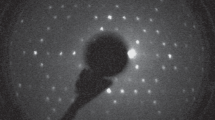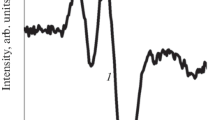Abstract
Transformations of the surface and bulk of nanoscale ytterbium films during the surface interactions of these films with different ligand molecules have been studied. It has been shown that a combination of two factors, i.e., the existence of a lone electron pair in CO and O2 molecules and the unoccupied 5d level lying near the Fermi level in metallic divalent ytterbium, causes the formation of a stable chemisorption state of the molecule-nanofilm surface layer in which donor-acceptor bonds between gas molecules and surface metal ions are formed. As a result, ytterbium on the surface and in the bulk of the nanofilm is oxidized to a non-autonomous trivalent electronic state. The depth to which this transition propagates in the nanofilm has been determined; its anomalously large value (from 9 to 22 layers according to different estimates) has been explained. It has also been shown that the ligand molecule layer on the ytterbium surface is filled in two stages. The two-stage mechanism of this process is reflected by the nonmonotonic behavior of concentration dependences of the work function of CO-Yb and O2-Yb structures.
Similar content being viewed by others
References
A. M. Shikin, Formation, Electronic Structure and Properties of Low-Dimensional Structures Based on Metals (VVM, St. Petersburg, 2011) [in Russian].
G. Cao and Y. Wang, Nanostructures and Nanomaterials: Synthesis, Properties, and Applications (World Scientific, Singapore, 2011), Vol. 2.
J.-W. He, W. K. Kuhn, L.-W. Leung, and D. W. Goodman, J. Chem. Phys. Chem. 93, 7463 (1990).
J.-W. He, C. A. Estrada, J. S. Corneille, and M.-Ch. Wu, Surf. Sci. 261, 164 (1992).
M. Rauh, B. Heping, and P. Wissmann, Appl. Phys. A 61, 587 (1995).
B. Hammer, Y. Morikawa, and J. K. Nørskov, Phys. Rev. Lett. 76, 2141 (1996).
P. Jakob and A. Schlapka, Surf. Sci. 601, 1556 (2007).
F. Voigts, F. Bebensee, S. Dahle, K. Volgmann, and W. Maus-Friedrichs, Surf. Sci. 603, 40 (2009).
N. Schumacher, K. Andersson, L. C. Grabow, M. Mavrikakis, J. Nerlov, and I. Chorkendorff, Surf. Sci. 602, 702 (2008).
F. Bebensee, F. Foigts, and W. Maus-Friedrichs, Surf. Sci. 602, 1622 (2008).
K. A. Gschneidner, J. Less-Common Met. 17, 13 (1969).
T. V. Krachino, M. V. Kuz’min, M. V. Loginov, and M. A. Mittsev, Phys. Solid State 39 (2), 224 (1997).
E. Bertel, G. Strasser, F. P. Netzer, and J. A. D. Matthew, Surf. Sci. 118, 387 (1982).
F. P. Netzer and J. A. D. Matthew, Rep. Prog. Phys. 49, 621 (1986).
M. Sancrotti, A. Rizzi, and F. Marchetti, Phys. Rev. B: Condens. Matter 37, 3120 (1988).
L. I. Johansson, J. W. Allen, I. Lindau, M. H. Hecht, and S. B. M. Hagstrom, Phys. Rev. B: Condens. Matter 21, 1408 (1980).
J. Schmidt-May, F. Gerken, R. Nyholm, and L. C. Davis, Phys. Rev. B: Condens. Matter 30, 5560 (1984).
M. V. Kuz’min and M. A. Mittsev, Phys. Solid State 52 (3), 625 (2010).
M. V. Kuz’min and M. A. Mittsev, Phys. Solid State 54 (2), 404 (2012).
M. V. Kuz’min and M. A. Mittsev, Phys. Solid State 54 (10), 2117 (2012).
D. V. Buturovich, M. V. Kuz’min, M. V. Loginov, and M. A. Mittsev, Tech. Phys. 58 (6), 803 (2013).
M. V. Kuz’min and M. A. Mittsev, Phys. Solid State 56 (7), 1449 (2014).
R. F. Gerken, J. Barth, R. Kammerer, L. I. Johansson, and A. Flodstrom, Surf. Sci. 117, 468 (1982).
L. C. Feldman and J. W. Mayer, Fundamentals of Surface and Thin Film Analysis (North-Holland, Amsterdam, 1986; Mir, Moscow, 1989).
G. Blyholder, J. Phys. Chem. 68, 2772 (1964).
J. Küpers, Surf. Sci. 36, 53 (1973).
G. Doyen and G. F. Ertl, Surf. Sci. 43, 197 (1974).
M. V. Kuz’min and M. A. Mittsev, Phys. Solid State 56 (12), 2548 (2014).
S. Wieling, S. L. Molodtsov, Th. Gantz, J. J. Hinarjeos, and C. Laubschat, Phys. Rev. B: Condens. Matter 58, 13219 (1998).
Y. Kubo, J. Phys. F: Met. Phys. 17, 383 (1987).
Author information
Authors and Affiliations
Additional information
Original Russian Text © D.V. Buturovich, M.V. Kuz’min, M.V. Loginov, M.A. Mittsev, 2015, published in Fizika Tverdogo Tela, 2015, Vol. 57, No. 9, pp. 1822–1829.
Rights and permissions
About this article
Cite this article
Buturovich, D.V., Kuz’min, M.V., Loginov, M.V. et al. Valence transition 2+ → 3+ induced in ytterbium nanofilms by CO and O2 molecules chemisorbed on their surface. Phys. Solid State 57, 1870–1877 (2015). https://doi.org/10.1134/S1063783415090061
Received:
Published:
Issue Date:
DOI: https://doi.org/10.1134/S1063783415090061




